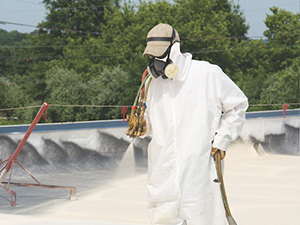
In Ozark, MO, where seasonal changes bring a mix of weather extremes, commercial building owners face constant challenges in maintaining roof integrity. From intense summer heat to freezing winters and heavy storms in between, a roofing system must do more than just cover your building—it must protect it thoroughly, year-round. That is where spray foam roofing stands out as a reliable solution.
If you own or manage a commercial property in Ozark, MO, and are looking for a roofing system that provides foolproof, year-round protection, call Brenneman Roofing today at (877) 370-6125 to learn more about the advantages of spray foam roofing.
Year-Round Protection
Seamless, Watertight Defense Against Moisture
Spray foam roofing is applied as a liquid that expands into a solid foam layer, seamlessly covering the entire roof surface. One of the keyways it delivers year-round protection is through its superior waterproofing ability.
Unlike traditional roofing systems that involve seams, nails, or joints—common entry points for water—spray foam forms a completely monolithic surface. This means no seams for water to seep through, instant sealing of minor cracks or gaps, and outstanding leak resistance even during heavy rainfall.
In the unpredictable spring and fall seasons in Ozark, MO, when storms can pop up without warning, this level of water resistance provides peace of mind for business owners.
Insulation That Adapts to All Seasons

Spray foam roofing is not just about moisture control—it is also one of the most energy-efficient roofing systems available. The foam has an exceptionally high R-value (a measure of thermal resistance), meaning it effectively keeps indoor temperatures stable.
This has dual benefits in the summer, it reflects sunlight and keeps cool air inside, and in the winter, it retains heat, reducing your building’s energy load.
In Ozark, MO, where both heating and cooling are essential throughout the year, spray foam roofing helps lower utility costs and eases the strain on HVAC systems. It is a sustainable choice that keeps buildings comfortable while delivering long-term savings.
Flexibility and Durability in Extreme Conditions
One of the standout advantages of spray foam roofing is its resilience. It remains stable under varying temperatures and doesn’t become brittle in the cold or overly soft in the heat.
Key features include:
Thermal flexibility: Expands and contracts with temperature without cracking.
High wind resistance: Adheres directly to the roof surface, reducing the risk of uplift.
Impact resistance: Absorbs small impacts from debris or hail without puncturing.
In a climate like Ozark, MO’s—with its harsh winters and scorching summers—this adaptability makes spray foam an ideal long-term investment for commercial roofs.
Low Maintenance and Long Lifespan
Unlike other commercial roofing systems that require frequent patching or sealing, spray foam roofs are easy to maintain and can last over 20 years with proper care. Minor damage can be repaired easily by reapplying the foam or protective coating, without the need to remove large sections of the roof.
Benefits include minimal disruptions to business operations during repair, and recoating that extends the roof’s life without full replacement, and resistance to mold, pests, and algae growth.
With regular inspections and occasional recoating, business owners in Ozark, MO can rely on spray foam roofing for long-term performance without the usual headaches of high-maintenance systems.
Environmentally Friendly Protection
For commercial businesses looking to adopt greener practices, spray foam roofing contributes to sustainability in multiple ways. It reduces energy consumption by improving insulation, prevents waste since it can be applied over existing roofs, and offers non-toxic options that meet environmental safety standards.
In the long run, choosing spray foam is not just about protecting your building, it is also about protecting your bottom line and the environment.
Spray Foam Roofing Experts!
If you want a commercial roofing solution that stands strong against wind, rain, sun, and snow, spray foam roofing is the foolproof choice. It is seamless, energy-efficient, durable, and low-maintenance—ideal for commercial facilities in Ozark, MO.
Let the professionals at Brenneman Roofing show you how spray foam can benefit your building through every season. Call (877) 370-6125 today to schedule an assessment or learn more about this innovative roofing solution.
FAQ
Can spray foam roofing be applied over an existing roof?
Yes, spray foam can be installed over most existing roofing systems, which helps reduce labor costs and environmental waste associated with full tear-offs.
Is spray foam safe for the environment?
Modern spray foams are manufactured with environmentally responsible blowing agents and are often part of energy-saving building strategies.
How often does spray foam roofing need to be recoated?
Typically, a spray foam roof is recoated every 10–15 years, depending on climate exposure and the condition of the protective coating.
Is spray foam roofing suitable for all commercial buildings?
Spray foam is ideal for most flat and low-slope commercial roofs. A professional inspection is necessary to determine compatibility with your existing structure.
